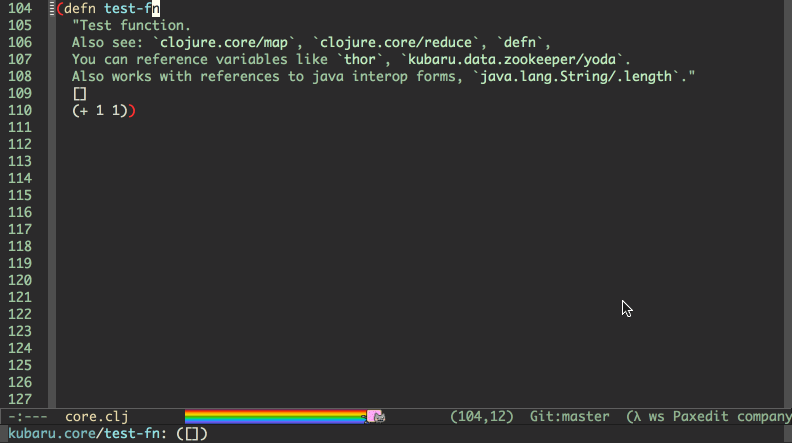Working with Documentation
Quick access to documentation is very important for productive development. That’s why CIDER puts a heavy emphasis on this and provides lot of documentation-related functionality.
Looking up Documentation
The most basic thing that you can do is go to some symbol and press C-c C-d C-d then. This open a documentation buffer containing all the relevant information about the thing referenced by the symbol (special form, var, Java method, etc).
You can also use the keybinding C-c C-d d. Most CIDER keymaps
provide two versions of the same keybinding (with or without the final Control),
as some people prefer to keep holding Control and some don’t.
|
Normally the command operates on the symbol at point. If invoked with a prefix argument, or no symbol is found at point, it will prompt for a symbol.
If using enrich-classpath, Java doc comments are available and rendered in the same way that Clojure docstrings are.
They’re often much more handy than opening Javadoc in a browser. Starting from CIDER 1.8.0,
the HTML-like language that they use is nicely rendered into syntax-colored strings, well-aligned tables, etc
|
JavaDoc
CIDER provides a quick access to the online Javadoc documentation
via the command cider-javadoc (C-c C-d j or C-c C-d C-j), using your default browser.
Normally the command operates on the symbol at point. If invoked with a prefix argument, or no symbol is found at point, it will prompt for a symbol.
If you don’t want CIDER to use an external browser to display the JavaDoc you can use the built-in EWW browser instead like this:
(setq browse-url-browser-function 'eww-browse-url)Searching in Docstrings
CIDER provides a handy alternative of clojure.repl/find-doc - cider-apropos-documentation (C-c C-d f or
C-c C-d C-f). This allows you to search in the docstrings of all loaded vars with the results presented
in Emacs’s apropos interface.
Alternatively you can use cider-apropos-documentation-select (C-c C-d e or C-c C-d C-e), which presents you the matching
results as a list in the minibuffer, so you can quickly select what you need (especially if you’re using some package like ido or vertico).
ClojureDocs
CIDER provides integration with the popular ClojureDocs service. You’ve got two main ways of interacting with ClojureDocs:
-
displaying the documentation in a dedicated buffer in Emacs via
cider-clojuredocs(C-c C-d C-c) -
opening the documentation in your default browser via
cider-clojuredocs-web(C-c C-d C-w)
The documentation is bundled with cider-nrepl as an EDN resource (or more
precisely - with orchard, which is dependency of cider-nrepl) and it’s a
snapshot of the ClojureDocs data. You can update it manually to the most recent
version with M-x cider-clojuredocs-refresh-cache.
Keep in mind that the documentation in ClojureDocs is limited only to Clojure and a few
Clojure Contrib libraries (e.g. core.async). ClojureScript is currently not supported
there.
| Check out this article if you’re curious about the internals of how CIDER interacts with ClojureDocs. |
Generating Documentation Cross References
Sometimes in your documentation strings, you’d like to be able to
point other programmers at different definitions. If you specify the
name of a definition as a fully qualified symbol, or surround it in
backticks (`...`) or Codox-style delimiters ([[...]]), CIDER
will convert these references into live links when it displays the
documentation string in the documentation buffer.
If the name is in another namespace, then you’ll have to include the fully qualified name in the docstring.
Example function with a docstring containing references:
(defn test-fn "Test function. Also see: clojure.core/map, clojure.core/reduce, `defn`. You can reference variables like `thor`, [[kubaru.data.zookeeper/yoda]]. Also works with references to java interop forms, `java.lang.String/.length`." [] (+ 1 1))
You can change the delimiters that CIDER uses to find references if
you want to support other reference formats. Simply update the regexp in
cider-doc-xref-regexp to match your preferred format. The first
group of the regexp should always match the cross-reference name. For
example, if you want to want to use Latex-style references
(\ref{...}) instead, the regexp would be:
(setq cider-doc-xref-regexp "\\\\ref{\\(?1:[^}]+\\)}")

Displaying Documentation as Tooltips
By default CIDER will show the documentation for the symbol under the mouse in a
tooltip (using an overlay) or your echo area. That’s controlled by the
configuration setting cider-use-tooltips. You can disable this behavior by
setting the variable to nil.
(setq cider-use-tooltips nil)
The tooltips will also be disabled if tooltip-mode is disabled or help-at-pt-display-when-idle is set to t.
Check out the documentation of help-at-pt-display-when-idle to understand better how the help-echo Emacs functionality works.
|
Keybindings
| Command | Keyboard shortcut | Description |
|---|---|---|
|
C-c C-d d |
Display doc string for the symbol at point. If invoked with a prefix argument, or no symbol is found at point, prompt for a symbol. |
|
C-c C-d j |
Display JavaDoc (in your default browser) for the symbol at point. If invoked with a prefix argument, or no symbol is found at point, prompt for a symbol. |
|
C-c C-d c |
Lookup symbol in ClojureDocs. |
|
C-c C-d w |
Open the ClojureDocs documentation for symbol in a web browser. |
|
C-c C-d a |
Apropos search for functions/vars. |
|
C-c C-d f |
Apropos search for documentation. |
|
C-c C-d e |
Apropos search for documentation & select. |